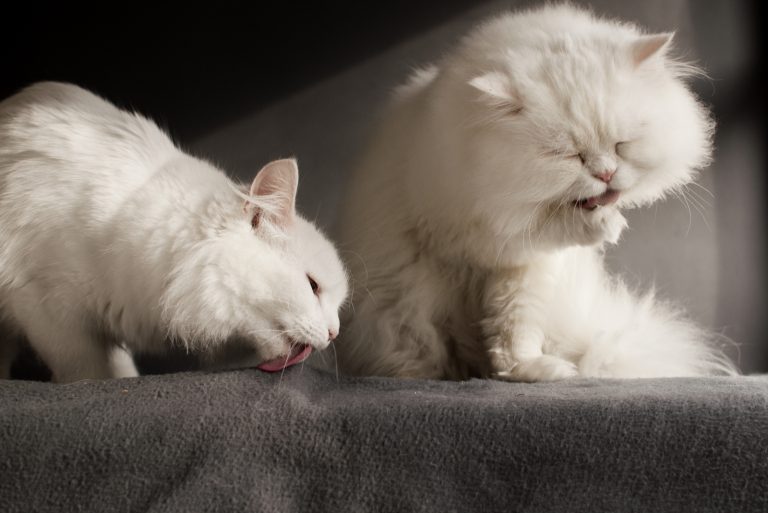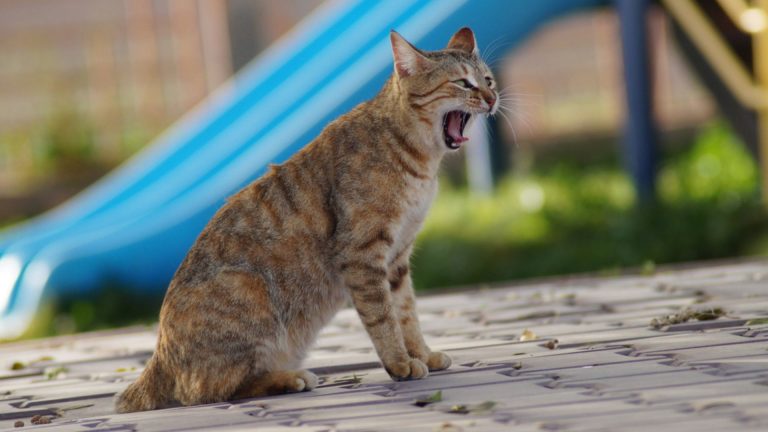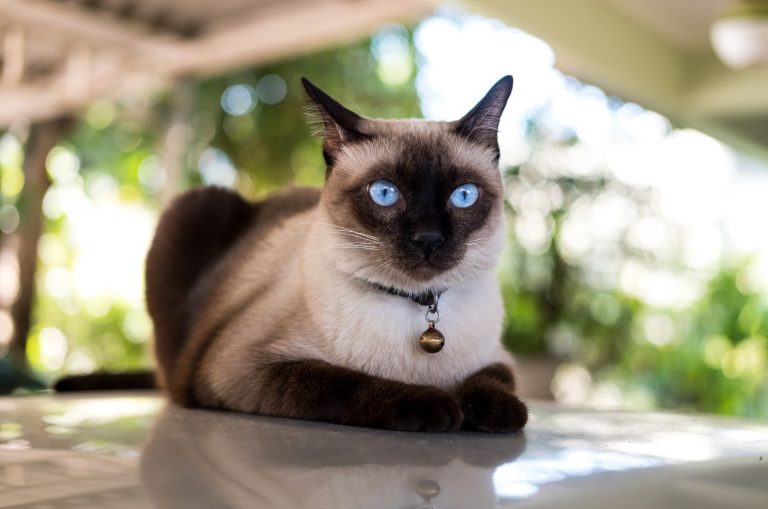6 Possible Causes Of Cat Coughing With Tongue Out (Explained)

Have you noticed your cat coughing with tongue out? If you have, you’re probably wondering what’s causing it, whether you should be worried, and what you can do about it.
The most common causes of a cat coughing with its tongue out are the presence of furballs, asthma, some kind of respiratory tract infection, heartworm infection, allergies, or having something stuck in the throat.
I know this might sound scary, but in this article, I will explain each of these health issues, what you can do to help your cat, and how to prevent the cough from arising again!
Cat Coughing With Tongue Out: 6 Potential Causes Explained
Below, I’ll present you with the most important information about the six most common causes of coughing.
Let’s begin!
1. Furball

A cat’s tongue captures loose hair when they groom themselves, and the hair is subsequently ingested.
Most of this hair moves smoothly through the digestive system, but a hairball might develop if some hair remains in the stomach. To get rid of the hairball, your cat will cough and then vomit.
A cat may begin gagging, retching, or behaving as though they are dry heaving and trying to vomit when trying to bring up a hairball.
When trying to get rid of a hairball, they occasionally emit a noise known as a “cough-gag-retch.”
PetMD notes that hairballs, apart from being a nuisance, can be very dangerous for the cat, as they can cause an intestinal blockage. Therefore, if you notice symptoms of intestinal blockage, such as vomiting without getting rid of the hairball, constipation, and lack of energy, you should visit a vet.
2. Feline Asthma
Asthma-related cough in cats is frequently mistaken for a cat trying to cough up a furball. However, asthma poses a much greater danger for a cat than a furball.
Therefore, recognizing the symptoms of feline asthma on time is crucial in ensuring a cat’s well-being.
However, don’t be alarmed – asthma in cats is treatable, and affected cats, with proper disease management, go on to live long and healthy lives!
According to VCA Animal Hospitals, asthma is an acute or chronic inflammation of the airways.
Asthmatic cats present the following symptoms:
• difficulty breathing
• dry cough
• open-mouth breathing
• shortness of breath
• wheezing
• lack of energy
While the exact causes of asthma are frequently unknown, cigarette smoke, dusty cat litter, vapors from household cleaners, pollen, and many other substances are thought to trigger an asthma attack.
Some purebred cats are at higher risk of developing asthma, most notably the Siamese cat, as well as obese and overweight cats.
3. Respiratory Tract Infection
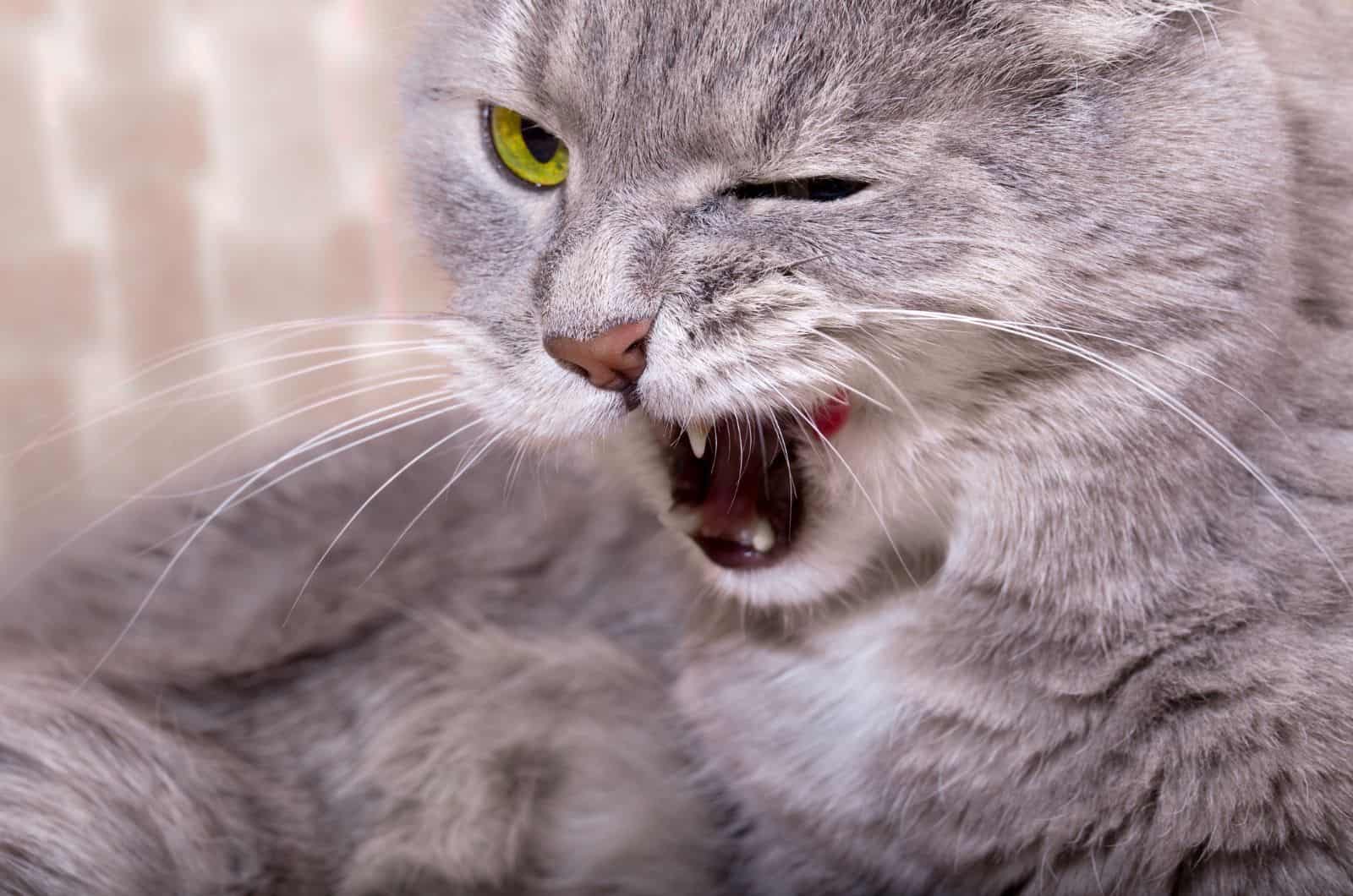
In high-density living environments like shelters and breeding catteries, respiratory infections are common. However, house cats can develop them as well.
These infections are caused by bacterial, viral, fungal, and protozoan pathogens.
A cat can have the following:
• an upper respiratory tract infection (infection affecting the nasal passages, sinuses, oral cavity, pharynx, and larynx)
• a lower respiratory tract infection (infection affecting the trachea, bronchi, and lungs)
Upper Respiratory Tract Infection
Symptoms of an upper respiratory infection are:
• eye discharge
• coughing
• sneezing
• mouth ulcers
• lethargy
Lower Respiratory Tract Infection
Symptoms of a lower respiratory infection are:
• coughing
• lethargy
• difficulty breathing
• shortness of breath
• rapid breathing
However, the cat can have an asymptomatic infection as well!
One common respiratory disease (or infection) affecting the lower respiratory tract is bronchitis. The bronchioles become inflamed as a result of this infection.
4. Heartworm Infection
Heartworm infection causes severe lung disease, heart failure, organ damage, and death in cats. Heartworm illness may infect both indoor and outdoor cats.
According to the American Heartworm Society, “Heartworm disease is a serious and potentially fatal disease in pets in the United States.”
The symptoms of heartworm infection are:
• vomiting
• blood in the vomit
• diarrhea
• breathing difficulty
• coughing
• loss of appetite
Dirofilaria immitis is a parasitic worm that causes this condition. The worms are transmitted through mosquito bites.
The worms are known as “heartworms” because the adults live in an infected animal’s heart, lungs, and blood vessels.
5. Allergies

Cats, like people, can have allergies. When an allergen-sensitive cat encounters an allergen, its immune system overreacts to it, producing many antibodies that should eliminate it from the cat’s system.
The most common allergens are:
• flea bites (flea saliva, to be more specific)
• inhalants from the cat’s environment (such as pollen and mold)
• food substances, usually specific proteins
The subsequent allergen-antibody fight causes allergy symptoms, such as
• sneezing, coughing, and wheezing
• itchy skin
• swollen nose and eyes
• runny nose and runny eyes
• vomiting and diarrhea
The most significant allergy symptoms impact a cat’s respiration. A cat may have respiratory problems causing swelling of the face, throat, or nose due to the body’s reaction to an allergen.
If not treated promptly, this swelling can induce coughing (particularly if the cat already has asthma), choking, wheezing, collapse, and death.
6. Having Something Stuck In The Throat
Cats like investigating their surroundings with their mouths, and as a result, they frequently swallow items they shouldn’t.
When a cat consumes a foreign object, it can become trapped in its esophagus rather than going into the stomach, resulting in an esophageal obstruction or blockage.
Sometimes a cat choking event is caused by a hairball that the cat cannot get rid of, but most incidents are caused by an object being caught in the cat’s throat.
Paper clips, staples, rubber bands, bottle caps, and small plastic items such as plastic toys are common choking hazards.
Signs a cat might have something stuck in its throat are:
• Drooling
• Extension of the head and neck
• Gagging
• Coughing
• Difficulty swallowing
• Restlessness
Treatment
1. Furball Treatment
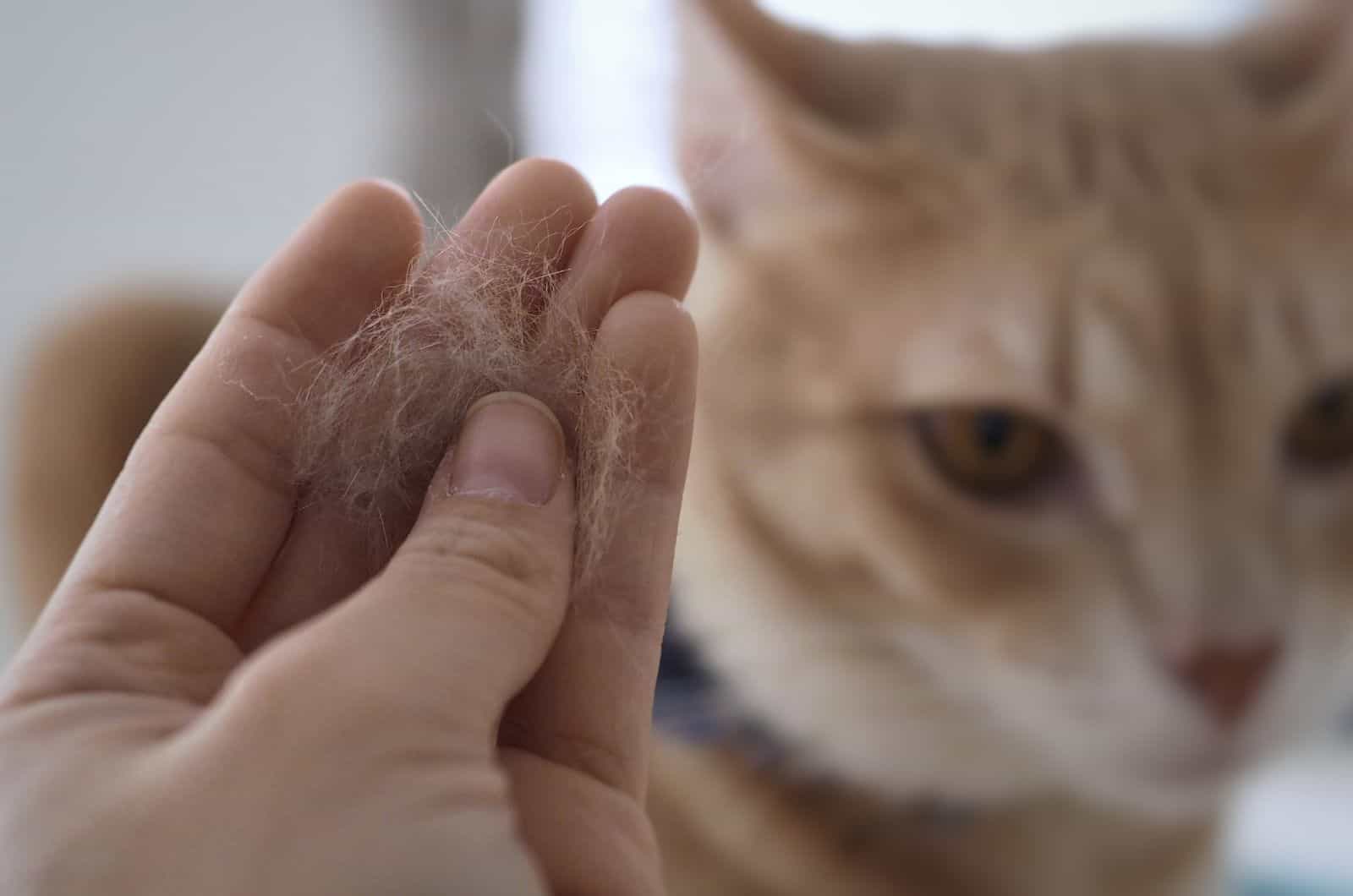
Tuna and other small canned fish are packed in oil, and oil can act as a lubricant that will help a cat pass the hairball painlessly. Therefore, giving a cat canned fish as a meal or a snack can be a good option.
You can also try putting some petroleum jelly on your cat’s paw. The jelly will fill their digestive tract when they lick it off, assisting the passage of the hair.
There are over-the-counter hairball remedies available. Most of the hairball products available today are mild laxatives that aid in the passage of hairballs through the digestive system.
The cat may develop hairballs due to obsessive grooming, usually caused by an underlying health issue. If you suspect this is the case, visiting the vet might be a good option.
2. Asthma Treatment
Chronic feline asthma is incurable but treatable, just like human asthma. The course of treatment is determined by how severe the asthma attacks are.
Some cats have a mild form of asthma, in which their symptoms do not interfere with their quality of life, while other cats’ symptoms interfere with the cat’s day-to-day activities and may even be life-threatening.
According to Cornel University College of Veterinary Medicine, asthma treatment most commonly involves using a bronchodilator medication to widen the airways, and corticosteroid medication to reduce bronchial inflammation.
They are both given to cats using a mask so the cat can inhale the aerosols for a short time. They can be given daily or as needed, depending on the severity of the cat’s asthma attacks.
3. Respiratory Tract Infection Treatment
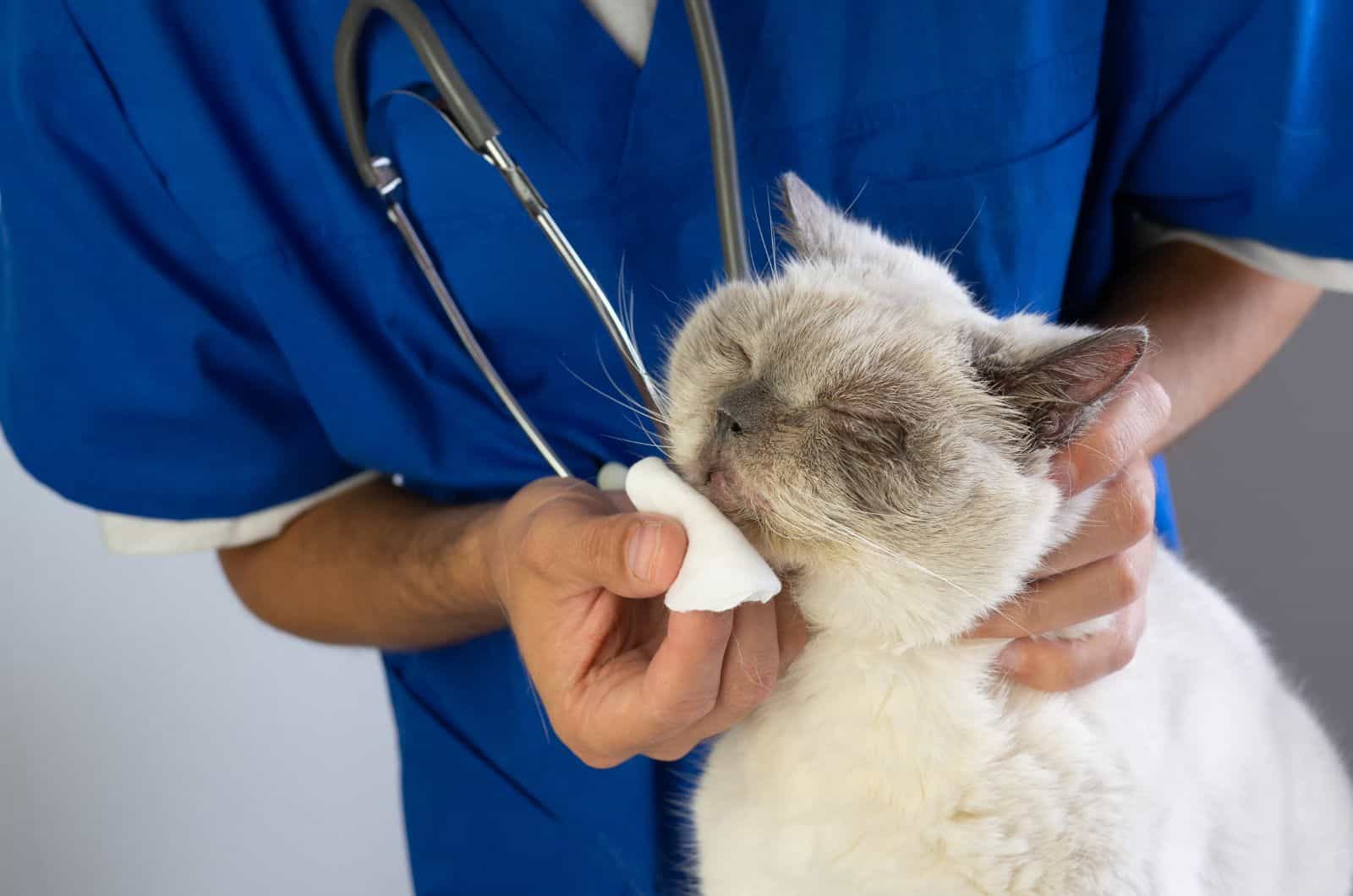
Most cats with a mild respiratory infection can be treated at home. Supportive care is essential, including ensuring proper nourishment and hydration.
This might be difficult as sore mouth sores can make it hard to eat and drink, and clogged nasal passages can prevent cats from smelling the foods that make them hungry.
Spending 10-15 minutes multiple times a day in a steamy bathroom may help cats with nasal or airway congestion.
Some cats will benefit from nose drops if the nasal discharge is especially severe or the nasal tissues become sore.
However, if at-home symptomatic care doesn’t seem to be helping, the cat should be taken to a pet hospital, as the cat’s respiratory infection may require veterinary attention.
Broad-spectrum antibacterial medications may be prescribed by the vet and administered to the cat to prevent subsequent bacterial infections from making the illness worse.
4. Heartworm Infection Treatment
There is no FDA-approved treatment to treat heartworm illness in cats, although symptoms can be treated.
Cats with a more severe heartworm infection may require additional supportive care such as intravenous fluids, oxygen therapy, cardiovascular medications, and antibiotics.
If mature heartworms can be spotted by ultrasonography, surgical removal may be possible for therapy.
However, surgery is dangerous; if the heartworms are not removed completely, significant consequences like shock and death might occur.
5. Allergies Treatment

The best strategy for treating cat allergies is to minimize the cat’s exposure to allergens.
However, it might take some time to figure out what is causing your cat’s allergies, and your veterinarian can do tests to narrow down the probable causes.
If The Allergy Is Inhalant-Related
Treatment includes the administration of corticosteroids (e.g., prednisone). In most circumstances, steroids will significantly reduce the allergic reaction and quickly improve the cat’s clinical symptoms.
Another treatment option is antihistamines or immunosuppressive drug therapy. These medications target the immune cells triggered by an allergic response to reduce the body’s hypersensitive reaction.
If The Allergy Is Flea-Related
Once the cat is infested with fleas, the best thing you can do is wash your cat and comb the fur out thoroughly to get rid of as many fleas as possible.
Shampoos, sprays, powders, and topical or oral medicines are available.
Cat owners commonly use topical medications. You put a few drops of the medication on the back of the cat’s neck (where the cat can’t lick it) and let it diffuse through the fur, killing the fleas.
However, it’s always best to prevent a flea infestation from happening in the first place.
If The Allergy Is Food-Related
If your cat’s allergies are food-related, you’ll need to monitor its reactions to specific components in order to determine which food is causing issues.
Your veterinarian may also recommend a limited-ingredient or prescription diet for cats with food allergies.
A food allergy diagnosis is made if your cat’s symptoms improve following the meal plan trial.
Lifelong feeding of a hypoallergenic diet is quite effective in managing food allergy skin disease in many cats.
6. Having Something Stuck In The Throat
If you suspect your cat has something stuck in the throat, you need to assess the situation based on your cat’s symptoms. Sometimes, the cat dislodges the object itself and spits or vomits out.
However, if your cat has been struggling to dislodge the foreign object for some time, you need to go to the vet.
Do not try dislodging the object yourself. Your vet is trained to deal with situations like this.
Once the vet has identified the foreign body, it will decide the best way to remove the object.
Endoscopy is a preferred method of removing foreign objects stuck in the cat’s throat. At the end of the endoscopic tube, forceps or medical tweezers grip the item or substance and remove it through the mouth.
Some foreign items, such as bones, can be pushed into the stomach by the vet and processed there. In these circumstances, the cat may not require surgical removal of the foreign object.
When Should I Worry About My Cat’s Cough?
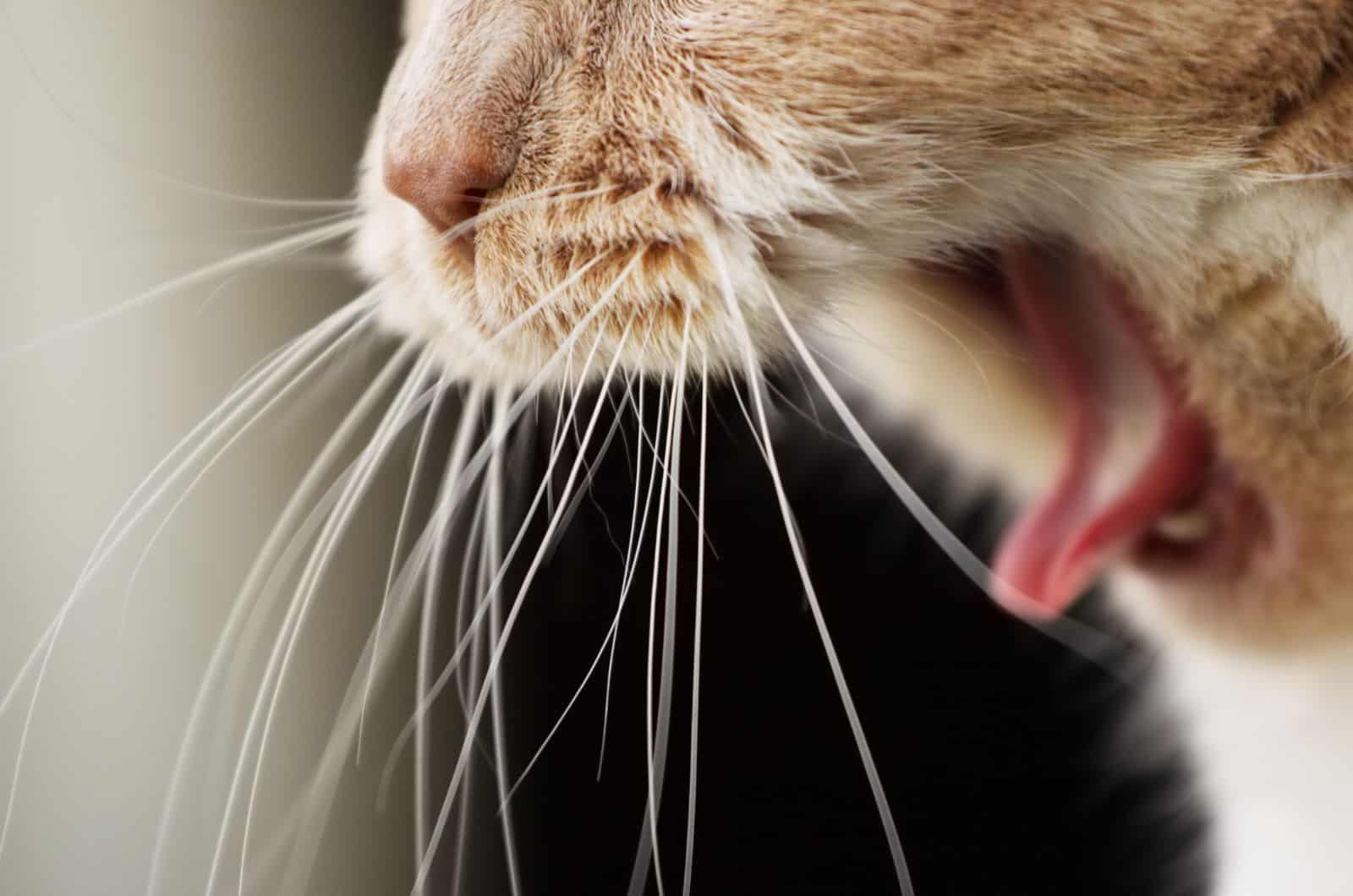
An occasional cough here and there is nothing to be worried about. Coughing is a normal way of clearing the airways for cats (and us, too!).
However, sometimes a cat’s cough indicates an underlying health issue.
If you notice your cat’s cough is:
• persistent (lasting for more hours or even days)
• is getting more severe,
then it would be best if you took your cat to the vet.
A persistent cough usually indicates a more serious respiratory tract issue, such as asthma or infection. If that’s the case, the cat needs veterinary treatment; the sooner, the better.
Another indication you should go to the vet is if your cat starts showing other signs of ill health, such as:
• nasal discharge
• wheezing
• loss of appetite
• lethargy
• diarrhea
• fever, etc.
A full physical examination; blood tests, x-rays, an endoscopy, and maybe a lung biopsy will all be required by the vet.
Prevention

1. Furball Prevention
Grooming your cat‘s fur regularly will help reduce hairballs. Taking your cat to a professional groomer is a great option as well.
The main goal is to reduce the number of loose hairs your cat might ingest when self-grooming.
Long-haired cat breeds like Persians and Maine Coons are more prone to developing hairballs.
Because they tend to ingest a lot of fur, cats that shed a lot or groom themselves obsessively are also more prone to hairballs.
2. Asthma Prevention
Preventing asthma from arising in the first place is not possible; if a cat has asthma, note that there’s nothing the cat owner could have done to prevent their feline from having it.
However, the cat owner can prevent the cat’s symptoms from getting more severe and lower the chances of an asthma attack as much as possible.
So, what can the cat owner do to help their kitty?
The cat owner needs to ensure the cat gets its disease-managing medication as prescribed by the vet and minimize the cat’s encounter with potential asthma attack triggers.
Using low-dust litter, not smoking in the room the cat is in, and avoiding household cleaners with strong scents can lower the cat’s chances of having an asthma attack.
However, if the cat’s asthma attack becomes severe, the cat might need veterinary care.
To conclude: the best prevention against feline asthma attacks is taking medication properly and reducing exposure to potential asthma attack triggers.
3. Respiratory Tract Infection Prevention
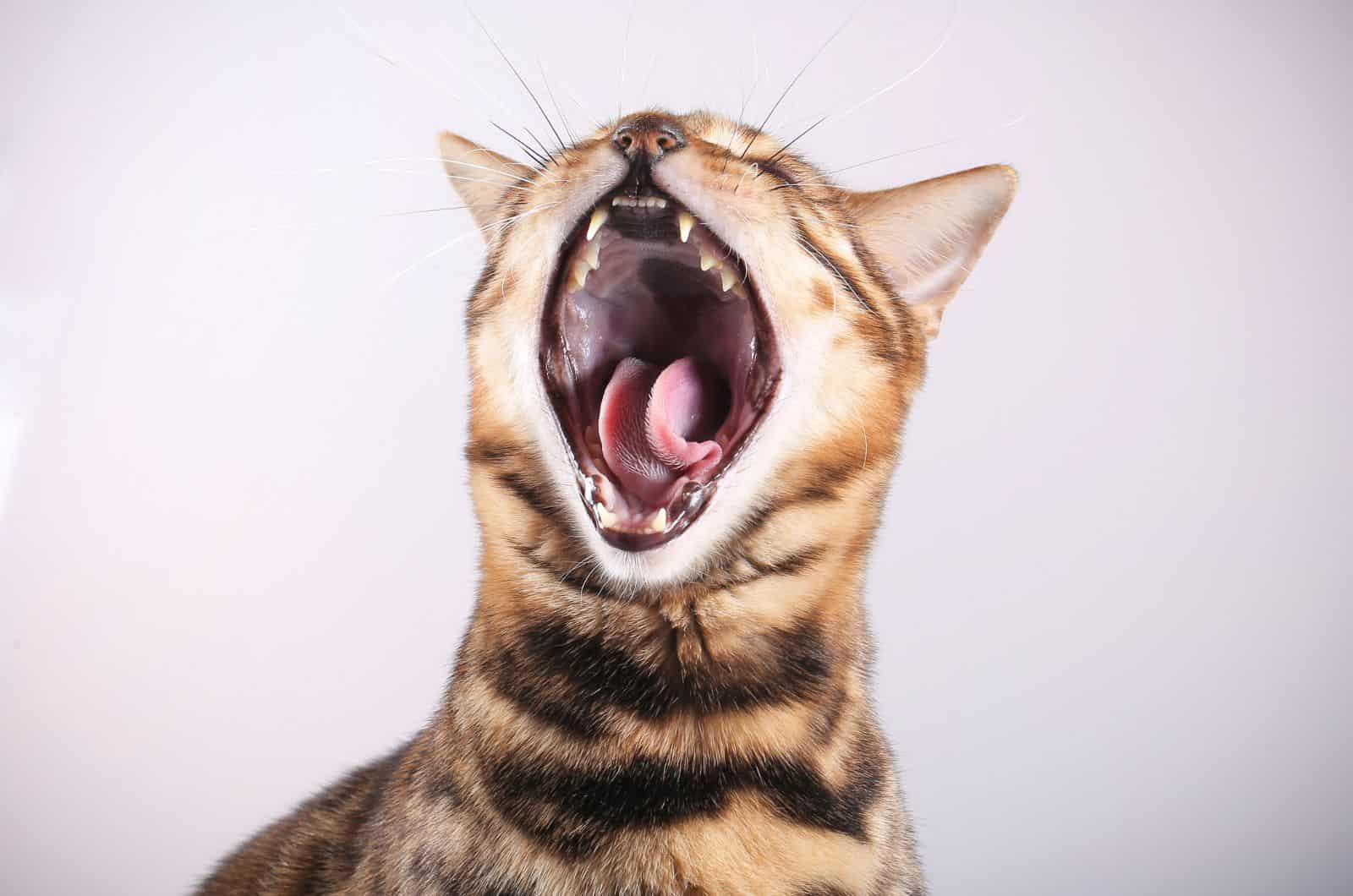
Provide a healthy lifestyle to boost your cat’s immune system and prevent respiratory infections.
Giving your cat regular veterinarian care, reducing stress, and providing healthy food at home are all necessary to support their immune systems.
Preventing illness requires routine veterinarian treatment at least once a year. The FVRCP vaccine is one of the most crucial preventative strategies, and every cat should be vaccinated.
Because some of the illnesses that cause respiratory infections are infectious, you should avoid letting your cat associate with other cats whose health state you don’t know.
4. Heartworm Infection Prevention
The FDA approves various heartworm preventive drugs for cats (and dogs). Treatment might be oral, injectable, or topical, but they all target heartworm larvae, not adults.
That’s why doctors recommend giving heartworm preventive medicine to pets all year.
Although there are fewer mosquitos in the winter, an animal might still get heartworms if the owner stops administering medicine during this season.
The U.S. Food & Drug Administration notes that heartworm prevention drugs are only available by prescription, so be wary of any website or business that claims to be able to provide medicine without a prescription.
5. Prevention Of Allergies
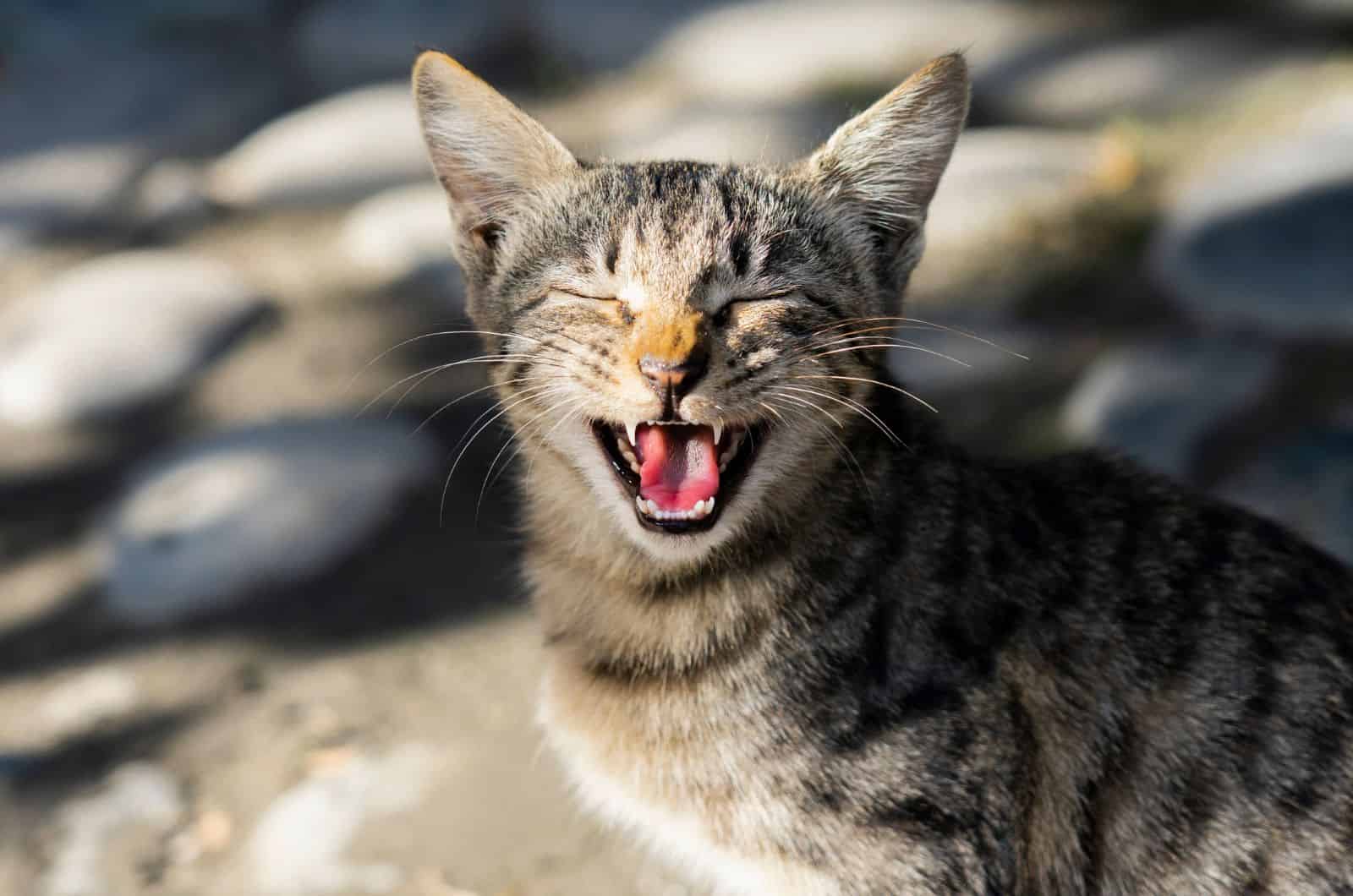
Cat owners can minimize a cat’s exposure to allergens, thereby minimizing allergy symptoms or even stopping allergic reactions from happening in the first place.
The sort of allergy a pet has will determine the best course of action for pet owners.
Maintaining a clean, dust-free environment and washing your cat regularly can help reduce allergy problems in cats allergic to dust, pollen, and mold.
When seasonal allergies develop, you should keep your flea-allergic cat indoors and avoid fleas using flea control medicine.
Suggested: Can Indoor Cats Get Fleas? Yes, But How To Prevent It?
6. Preventing A Cat From Getting Something Stuck In The Throat
When you’re not home, curious cats will go exploring, so keep your belongings in a pet-proof spot.
Never allow your cat to play with garbage such as wadded-up aluminum foil or plastic bags. She may enjoy herself, but it only takes a second for those things to become lodged in her throat.
Some cat toys might also be hazardous. The cat owner should avoid buying toys with dangling embellishments like feathers, bells, and googly eyes.
Choose toys larger than your cat’s mouth, such as balls, or toy mice.
FAQ

Why Is My Cat Wheezing With His Tongue Out?
Wheezing in cats can be brought on by a variety of conditions, from minor airway irritation brought on by allergies or dust inhalation to severe, occasionally fatal, respiratory tract infections.
If your cat’s wheezing doesn’t subside in a day or two, go to the vet.
What Should I Do If My Cat Is Coughing And Its Tongue Is Out?
You need to keep an eye on your cat’s coughing – is it getting better, staying the same, or getting worse? If your cat’s cough has not subsided in a few days, or other ill health symptoms arise, I suggest going to the vet.
Your cat might be battling an underlying health issue, most likely a viral or bacterial respiratory tract infection. The sooner the treatment starts, the sooner your cat’s health will be back in order.
Is Cat Coughing An Emergency?
It’s common for cats to cough from time to time when they need to clear their airways. An occasional cough is nothing to be worried about.
However, if your cat keeps coughing and the cough worsens over time, that might become a medical emergency. There are several life-threatening health issues that cause cat coughing, so it’s best to check in with the vet.
Why Is My Cat Coughing Up Blood?
A cat might be coughing up blood due to a physical trauma that has caused a pulmonary hemorrhage, lung tumors, poisoning, or something stuck in the throat. Whatever the cause, I suggest you visit the vet as soon as possible.
Wrapping Up

Furballs, asthma, respiratory tract infection, heartworm infection, allergies, or an object stuck in the cat’s throat can all cause a cat to cough with its tongue out.
A cat coughing with tongue out might be something you don’t need to worry about, but it can also indicate a more serious health issue your cat is battling.
You can determine if your cat needs to visit a vet based on the presence of your cat’s other symptoms. Either way, I’m sure you’ll take great care of your feline friend!

